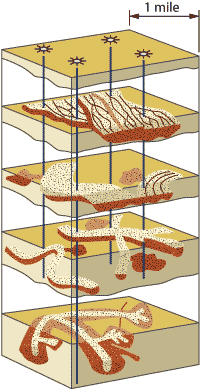What's new in production
New software can help identify bypassed reserves
Bypassed oil. Most oil fields only produce 30% to 40% of the original oil in place, sometimes more using secondary recovery. Secondary recovery sweeps the reservoir accessible by the wells, but many oil fields are highly compartmentalized with oil trapped in unproducible segments, Fig. 1. Getting to this oil requires knowing where the oil is trapped and devising new well paths to reach the oil. This can be expensive, if vertical wells are required. However, RSS technology, coupled with intelligent completions, can open these compartments and extract this oil. Only one question remains: Where is the oil, so operators can plan the well?
The answer lies in smarter use of the latest seismic exploration technology for reservoir studies, coupled with traditional tracer conductivity field studies. In the past, computer power to process the data was a limit, but faster processing technology has brought former supercomputer power to the desktop, making detailed reservoir study possible. According to Chandra Nautiyal, NETL’s technical expert coordinating the project, researchers at Texas A&M University (TAMU) and The University of Texas, in a joint venture with the Office of Fossil Energy’s National Energy Technology Laboratory (NETL) within the US Department of Energy, have developed new computer software. The software uses 3D seismic data, in conjunction with tracer data and field production history data, to identify reservoir areas that should hold bypassed reserves. The approach adapts sophisticated computer modeling to the PC, using generalized travel-time inversion. Older 2D seismic surveys help define the pre-production state of the field, which can then be overlaid with newer 3D surveys to define rock parameters and individual reservoir heterogeneity. Understanding these reservoir details allows the field’s production history to be modeled and matched. The research has produced a cost-effective way to feed 3D-seismic derived information into one million-celled reservoir models, streamlining the analysis process while providing manpower and computation-time savings. The project’s three-year life ended last December and cost $890,000, which was split between NETL and the universities. Shell and Chevron have already put the new software to work, and widespread industry interest has led to an eight-company research and development consortium to advance this technology. In addition, TAMU researchers have won a National Science Foundation grant to continue the work. DOE hopes this new software will help the industry reach some of the estimated 218 billion barrels of bypassed oil remaining in mature domestic fields. Application of this technology to other world areas should bring many more barrels to market. Well done; now, let’s get to that oil! State investment. Cantarell and Ku-Maloob-Zaap (KMZ) fields will receive $4.78 billion to expand production, according to Vinicio Suro, Pemex E&P planning director. KMZ will receive $2.4 billion to raise production from 496,000 bopd to around 500,000 bopd. Most of the new money will be spent in Canterell field, where production dropped to 1.79 million bopd in 2006, down 12% from 2005. The state company hopes to slow natural decline and produce over 1.53 million bopd this year. Saudi Arabia is planning to add 100 Tcf of new gas reserves over the next 10 years. World demand for natural gas is expected to double to 182 Tcf by 2030, according to the US Energy Information Administration’s statistical projections. To help meet this growing demand from industry and power plants, the state-owned company will drill 186 exploration wells in step with the rising demand. As part of the gas production expansion, Saudi Aramco will develop Karan field, a natural gas deposit in the Persian Gulf. The field holds an estimated 9 Tcf. When development work is completed in 2011, Karan field will produce over 770 MMcfd. New output. Talisman Energy began flowing oil from Tweedsmuir and Tweedsmuir South fields in Block 21/1a of the UK North Sea, about 100 miles northeast of Aberdeen. After topsides enhancements later this year, oil flow will increase to 51,000 bopd. The fields include one horizontal producer and one injection well, apiece, and form a four-well subsea system, tied-back 34 mi to the Piper B platform. Talisman Energy Norge began producing a total of about 24,000 bopd from two wells in the Gyda and Brage fields in the Norwegian North Sea. The Gyda 2/1-A-02A well came onstream mid-April and is producing 10,200 bpd of 42° API dry oil. The company will drill two infill wells in 2007. PetroChina found major new oil reserves in Bohai Bay near Tianjin, China. The company estimates that 7.33 billion boe are awaiting development in Jidong field in the Nanpu Block. The field is large covering more than 580 mi2 and has four productive structures. Amerada Hess began producing over 20 MMcfd of gas, along with small amounts of oil and condensate from Ujung Pangkah field, east Java, Indonesia. Production will be expanded to 100 MMcfd and 20,000 bopd by 2009, according to an Indonesian regulator. Apache Corp. discovered oil in Well Zaina No.2 in the East Bahariya concession of the Western Desert of Egypt. The well tested 1,067 bopd from the Abu Roash G-10 sand. The first well, Zaina No. 1, is online producing 560 bopd.
|
||||||||||||
- What's new in production (February 2024)
- Prices and governmental policies combine to stymie Canadian upstream growth (February 2024)
- U.S. operators reduce activity as crude prices plunge (February 2024)
- U.S. producing gas wells increase despite low prices (February 2024)
- U.S. drilling: More of the same expected (February 2024)
- U.S. oil and natural gas production hits record highs (February 2024)





